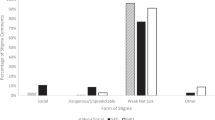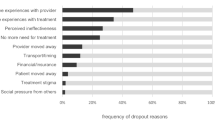Abstract
Help seeking for anxiety tends to be low in adolescents. Identifying modifiable factors that may facilitate help seeking is important. The aim of the current study is to test the effects of generalized anxiety disorder (GAD) literacy and stigma (personal and perceived) on attitudes and intentions toward seeking help from professionals and key adult sources. 1767 adolescents aged 12–18 years participated in the current study and completed measures of GAD literacy, GAD stigma, professional help-seeking attitudes, and intentions to seek help from a range of sources. The results of the study found that participants had limited GAD literacy and up to 20% personally agreed with stigmatising statements about GAD. Participants reported greater intentions to seek help from parents than from formal sources. More positive attitudes toward seeking help were associated with higher levels of GAD literacy (p < 0.001) and lower personal GAD stigma (p < 0.001). Lower perceived GAD stigma was associated with increased intentions to seek help from their mothers (p < 0.05) or fathers (p < 0.01), while lower personal GAD stigma was also associated with help-seeking intentions from their mothers (p < 0.05). Higher perceived GAD stigma was associated with intentions to seek help from nobody (p < 0.001). Overall, the current study highlights the important role that parents can play in the help-seeking process for adolescents, with parents often the most accessible source of help. Improving parent and adolescent knowledge and attitudes towards GAD may help to improve early help seeking in young people.
Similar content being viewed by others
References
Reavley NJ, Cvetkovski S, Jorm AF, Lubman DI (2010) Help-seeking for substance use, anxiety and affective disorders among young people: results from the 2007 Australian National Survey of Mental Health and Wellbeing. Aust N Z J Psychiatry 44:729–735
Beesdo K, Knappe S, Pine DS (2009) Anxiety and anxiety disorders in children and adolescents: developmental issues and implications for DSM-V. Psychiatr Clin North Am 32:483–524
Kessler RC, Avenevoli S, Costello EJ, Georgiades K, Green JG, Gruber MJ, He J-p, Koretz D, McLaughlin KA, Petukhova M, Sampson NA, Zaslavsky AM, Merikangas KR (2012) Prevalence, persistence, and sociodemographic correlates of DSM-IV disorders in the National Comorbidity Survey Replication Adolescent Supplement. Arch Gen Psychiatry 69:372–380
Merikangas KR, He J-p, Burstein M, Swendsen J, Avenevoli S, Case B, Georgiades K, Heaton L, Swanson S, Olfson M (2011) Service utilization for lifetime mental disorders in U.S. adolescents: results of the National Comorbidity Survey-Adolescent Supplement (NCS-A). J Am Acad Child Adolesc Psychiatry 50:32–45
Wang PS, Angermeyer M, Borges G, Bruffaerts R, Tat Chiu W, De Girolamo G, Fayyad J, Gureje O, Haro JM, Huang Y, Kessler RC, Kovess V, Levinson D, Nakane Y, Oakley Brown MA, Ormel JH, Posada-Villa J, Aguilar-Gaxiola S, Alonso J, Lee S, Heeringa S, Pennell B-E, Chatterji S, Ustün TB (2007) Delay and failure in treatment seeking after first onset of mental disorders in the World Health Organization's World Mental Health Survey Initiative. World Psychiatry 6:177–185
Rickwood DJ, Deane FP, Wilson CJ (2007) When and how do young people seek professional help for mental health problems? Med J Aust 187:S35–39
Wilson CJ, Deane FP (2010) Help-negation and suicidal ideation: the role of depression, anxiety and hopelessness. J Youth Adolesc 39:291–305
DeLuca JS (2019) Conceptualizing adolescent mental illness stigma: youth stigma development and stigma reduction programs. Adolesc Res Rev. https://doi.org/10.1007/s40894-018-0106-3
Coles ME, Ravid A, Gibb B, George-Denn D, Bronstein LR, McLeod S (2016) Adolescent mental health literacy: young people's knowledge of depression and social anxiety disorder. J Adolesc Health 58:57–62
Reavley NJ, Jorm AF (2011) Young people's recognition of mental disorders and beliefs about treatment and outcome: findings from an Australian National Survey. Aust N Z J Psychiatry 45:890–898
Gulliver A, Griffiths KM, Christensen H (2010) Perceived barriers and facilitators to mental health help-seeking in young people: a systematic review. BMC Psychiatry 10:113
Calear AL, Griffiths KM, Christensen H (2011) Personal and perceived depression stigma in Australian adolescents: magnitude and predictors. J Affect Disord 129:104–108
Griffiths KM, Christensen H, Jorm AF (2008) Predictors of depression stigma. BMC Psychiatry 8:25
Jorm AF (2000) Mental health literacy. Public knowledge and beliefs about mental disorders. Br J Psychiatry 177:396–401
Jorm AF, Korten AE, Jacomb PA, Christensen H, Rodgers B, Pollitt P (1997) "Mental health literacy": a survey of the public's ability to recognise mental disorders and their beliefs about the effectiveness of treatment. Med J Aust 166:182–186
Schofield CA, Dea Moore C, Hall A, Coles ME (2016) Understanding perceptions of anxiety disorders and their treatment. J Nerv Ment Dis 204:116–122
Clement S, Schauman O, Graham T, Maggioni F, Evans-Lacko S, Bezborodovs N, Morgan C, Rüsch N, Brown JSL, Thornicroft G (2014) What is the impact of mental health-related stigma on help-seeking? A systematic review of quantitative and qualitative studies. Psychol Med 45:11–27
Nearchou FA, Bird N, Costello A, Duggan S, Gilroy J, Long R, McHugh L, Hennessy E (2018) Personal and perceived public mental-health stigma as predictors of help-seeking intentions in adolescents. J Adolesc 66:83–90
Yap MB, Wright A, Jorm AF (2011) The influence of stigma on young people's help-seeking intentions and beliefs about the helpfulness of various sources of help. Soc Psychiatry Psychiatr Epidemiol 46:1257–1265
Eisenberg D, Downs MF, Golberstein E, Zivin K (2009) Stigma and help seeking for mental health among college students. Med Care Res Rev 66:522–541
Yap MB, Reavley NJ, Jorm AF (2013) Associations between stigma and help-seeking intentions and beliefs: findings from an Australian National Survey of young people. Psychiatry Res 210(3):1154–1160
Wright A, Jorm AF, Harris MG, McGorry PD (2007) What's in a name? Is accurate recognition and labelling of mental disorders by young people associated with better help-seeking and treatment preferences? Soc Psychiatry Psychiatr Epidemiol 42:244–250
Wright A, Jorm AF, Mackinnon AJ (2012) Labels used by young people to describe mental disorders: which ones predict effective help-seeking choices? Soc Psychiatry Psychiatr Epidemiol 47:917–926
Coles ME, Coleman SL (2010) Barriers to treatment seeking for anxiety disorders: initial data on the role of mental health literacy. Depress Anxiety 27:63–71
Calear AL, Christensen H, Griffiths KM, Mackinnon A (2013) The Y-Worri Project: study protocol for a randomised controlled trial. Trials 14:76
Griffiths KM, Batterham PJ, Barney L, Parsons A (2011) The Generalised Anxiety Stigma Scale (GASS): psychometric properties in a community sample. BMC Psychiatry 11:184
Busby Grant J, Bruce CP, Batterham PJ (2016) Predictors of personal, perceived and self-stigma towards anxiety and depression. Epidemiol Psychiatr Sci 25:247–254
Gulliver A, Griffiths KM, Christensen H, Mackinnon A, Calear AL, Parsons A, Bennett K, Batterham PJ, Stanimirovic R (2012) Internet-based interventions to promote mental health help-seeking in elite athletes: an exploratory randomized controlled trial. J Med Internet Res 14:e69
Fischer EH, Farina A (1995) Attitudes toward seeking professional psychologial help: a shortened form and considerations for research. J Coll Stud Dev 36:368–373
Wilson CJ, Deane FP, Ciarrochi JV, Rickwood D (2005) Measuring help seeking intentions: properties of the General Help Seeking Questionnaire. Can J Couns 39:15–28
Spitzer RL, Kroenke K, Williams JB, Lowe B (2006) A brief measure for assessing generalized anxiety disorder: the GAD-7. Arch Intern Med 166:1092–1097
Radloff LS (1977) The CES-D scale: a self-report depression scale for research in the general population. Appl Psychol Meas 1:385–401
Reavley NJ, Jorm AF (2011) Young people's stigmatizing attitudes towards people with mental disorders: findings from an Australian national survey. Aust N Z J Psychiatry 45(12):1033–1039
Calear AL, Batterham PJ, Griffiths KM, Christensen H (2017) Generalized anxiety disorder stigma in adolescents: personal and perceived stigma levels and predictors. Stigma and Health 2:208–215
Acknowledgements
This study was funded by the Vincent Fairfax Family Foundation. ALC, PJB and MT are supported by National Health and Medical Research Council (NHMRC) Fellowships 1122544, 1158707 and 1138710 respectively. We would like to acknowledge and thank the staff and students who participated in the Y-Worri study.
Author information
Authors and Affiliations
Corresponding author
Ethics declarations
Conflict of interest
The authors declare that they have no conflict of interest.
Ethical approval
The authors assert that all procedures contributing to this work comply with the ethical standards of the relevant national and institutional committees on human experimentation and with the 1964 Helsinki Declaration and its later amendments. The current study received ethical approval from the Australian National University Human Research Ethics Committee (protocol number 2010/550) and the relevant education departments responsible for the schools that participated in the trial.
Rights and permissions
About this article
Cite this article
Calear, A.L., Batterham, P.J., Torok, M. et al. Help-seeking attitudes and intentions for generalised anxiety disorder in adolescents: the role of anxiety literacy and stigma. Eur Child Adolesc Psychiatry 30, 243–251 (2021). https://doi.org/10.1007/s00787-020-01512-9
Received:
Accepted:
Published:
Issue Date:
DOI: https://doi.org/10.1007/s00787-020-01512-9




